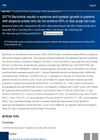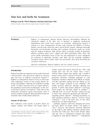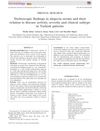TLDR Hair loss is common, influenced by genetics and androgens, and can affect mental health.
The document discussed androgenetic alopecia, noting that it was common in caucasoid races and involved the transformation of terminal to vellus hair follicles, particularly on the vertex, from puberty onwards. It was observed in both sexes, though women often experienced a diffuse form. The pathogenesis of baldness was not fully understood, but it required a genetic predisposition and the presence of androgens. The key factor was the follicular response to androgens, rather than the level of circulating androgens. The document also highlighted that common baldness was not typically linked to endocrine disease but could have significant psychological impacts, potentially leading to psychiatric issues.
 1 citations
,
September 2022 in “Journal of The American Academy of Dermatology”
1 citations
,
September 2022 in “Journal of The American Academy of Dermatology” Baricitinib helps grow eyebrows and eyelashes in severe alopecia areata patients.
1 citations
,
January 2022 in “Springer eBooks” 
Baldness is often hereditary and linked to male hormones, becoming noticeable when half the hair is lost.
 16 citations
,
May 2017 in “American Journal of Clinical Dermatology”
16 citations
,
May 2017 in “American Journal of Clinical Dermatology” The document concludes that more research is needed to understand and treat Beard Alopecia Areata due to limited current knowledge and evidence.
 39 citations
,
September 2013 in “Journal of Cosmetic Dermatology”
39 citations
,
September 2013 in “Journal of Cosmetic Dermatology” Herbs can potentially treat hair loss by inhibiting a key enzyme and promoting hair growth, and deficiencies in zinc, biotin, and iron are linked to hair loss.
 26 citations
,
August 2013 in “Australasian Journal of Dermatology”
26 citations
,
August 2013 in “Australasian Journal of Dermatology” Certain scalp patterns can indicate the severity and activity of hair loss in Turkish alopecia patients.
December 2002 in “대한피부과학회지” Higher androgen receptor levels in bald areas may cause hair loss, while estrogen receptors have less impact.
22 citations
,
January 1987 in “Dermatology” Hair loss is common, influenced by genetics and androgens, and can affect mental health.






